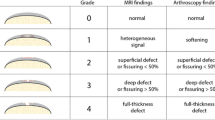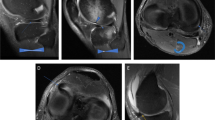Summary
Cadaveric material is often used to guide and validate the interpretation of magnetic resonance imaging (MRI) studies. Direct correlation is achieved when the cadaver material is imaged and then directly sectioned in the plane of the image. Indirect correlation, where the cadaveric sections are compared with unrelated in-vivo images, is easier and more commonly used. Technical difficulties associated with the direct method include preservation of form and composition of the tissues, and the choice of the correct location and plane in which to section the cadaver. Using an MRI compatible ruler, designed to assist the direct correlation of MRI and cadaveric sections, we have examined 10 preserved (embalmed) cadaveric knees using different MRI sequences on several occasions. Despite these variations, subsequent sectioning of the cadaveric knees has shown good correlation with the MR images. Of 54 MR images compared with cadaveric sections, anatomical correlation was rated by independent observers as good or perfect in 47 (87%). This new, versatile and simple method can make better use of our preserved human cadaveric material and has potentially wide application; we are now developing it further to assess the technical capabilities of novel imaging sequences.
Résumé
Pour guider ou valider une interprétation d'examens IRM, on a souvent recours au cadavre. On obtient une corrélation directe par confrontation de la coupe IRM d'une pièce avec la coupe anatomique faite dans le même plan. Une autre méthode plus facile et plus usuelle dite de corrélation indirecte est celle où une coupe IRM prise sur le vif est comparée avec des coupes sur le cadavre sans rapport direct. Elle ne présente pas les difficultés techniques d'une corrélation directe, qui requiert d'une part la préservation de forme et de la composition des tissus, et d'autre part l'exactitude du plan de coupe sur le cadavre qui doit coïncider avec la coupe IRM. Une règle IRM-compatible, conçue pour réaliser cette corrélation directe, a permis l'étude de 10 genoux de sujets embaumés, avec des séquences différentes d'IRM, à plusieurs reprises. En dépit des variations, la corrélation s'avère satisfaisante. Sur 54 coupes IRM soumises à cette corrélation, la corrélation est bonne ou parfaite pour 47 d'entre elles selon des observateurs differents, soit pour 87% des coupes. Cette méthode nouvelle, souple et simple, permet de tirer le meilleur usage du matériel humain conservé, avec un champ d'applications potentielles large. Nous sommes en train de la développer davantage pour l'évaluation des capacités techniques de nouvelles séquences d'image.
Similar content being viewed by others
References
Balaban DJ, Goldfarb NI (1983) Medical evaluation of health care technologies. In: Culyer AJ, Horisberger B (eds) Economic and medical evaluation of health care technologies. Springer-Verlag, Berlin Heidelberg New York, pp 16–31
Burger PC (1990) Postmortem (specimen) MR. Am J Neuroradiol 11: 912–3
Ellis H, Logan BM, Dixon A (1991) Human cross sectional anatomy: Atlas of body sections and CT images. Butterworth-Heinmann, Oxford, p 4
Fineberg HV, Bauman R, Sosman M (1977) Computerized cranial tomography: Effect on diagnostic and therapeutic plans. JAMA 238: 224–7
Hodler J, Trudell D, Kang HS, Kjellin I, Resnik D (1992) Inexpensive technique for performing MR-Pathologic correlation in cadavers. Invest Radiol 27: 323–325
Kent DL, Larson EB (1992) Disease, level of impact, and quality of research methods: three dimensions of clinical efficacy assessment applied to magnetic resonance imaging. Invest Radiol 27: 245–254
Kramer MS, Feinstein AR (1981) Clinical Biostatistics LIV. The biostatistics of concordance. Clin Pharmacol Ther 29: 111–123
Logan BM (1989) A basic synopsis of the ‘Cambridge’ procedure for the preservation of whole human cadavers. Inst Anat Sciences J 3: 25
Lufkin R, Rauschning W, Seeger L, Bassett L, Hanafee W (1987) Anatomic correlation of cadaver cryomicrotomy with magnetic resonance imaging. Surg Radiol Anat 9:299–302
Mackenzie R, Shah NJ, Doran S and Dixon AK (1993) Technical note: a multi-purpose ruler for magnetic resonance imaging. Br J Radiol 66: 545–547
Reicher MA (1993) An atlas of normal multiplanar anatomy of the knee joint. In: Mink JA, Reicher MA, Crues JV, Deutsch AL (eds) MRI of the knee, 2nd edn, Raven Press, New York, pp 51–90
Wright JG, McCauley TR, Bell SM and McCarthy S (1992) The reliability of radiologists' quality assessment of MR pelvic scans. J Comput Assist Tomogr 16:592–596
Author information
Authors and Affiliations
Rights and permissions
About this article
Cite this article
Mackenzie, R., Logan, B., Shah, N. et al. Direct anatomical-MRI correlation: the knee. Surg Radiol Anat 16, 183–192 (1994). https://doi.org/10.1007/BF01627593
Received:
Accepted:
Issue Date:
DOI: https://doi.org/10.1007/BF01627593




